Building Information Modelling and MEP Assessment - Project Analysis
VerifiedAdded on 2019/09/22
|8
|1228
|304
Report
AI Summary
This report provides a comprehensive assessment of Building Information Modelling (BIM) and its integration with Mechanical, Electrical, and Plumbing (MEP) systems. It begins with an introduction to BIM, highlighting its background, elements (Technologies, Information, People, Policies, Processes), and significant features, emphasizing its role in reducing life cycle costs and enhancing productivity in construction. The assessment's scope involves a critical analysis of existing structures using BIM tools, specifically Autodesk Revit, to examine industrial applications of BIM with MEP packages, its importance in construction, and its impact on design projects. The report delves into the application of BIM approaches to solve design problems, the importance of BIM and MEP in project development, and how BIM supports different stages of design projects in a multidisciplinary environment. It also covers research studies on electrical, mechanical, plumbing, and fire-related applications within the BIM environment, addressing industrial standards and information usage to ensure an effective BIM environment. The report concludes by summarizing the key findings and the benefits of BIM in the construction industry.

BUILDING INFORMATION MODELLING AND MEP ASSESSMENT
APRIL 15, 2019
APRIL 15, 2019
Paraphrase This Document
Need a fresh take? Get an instant paraphrase of this document with our AI Paraphraser
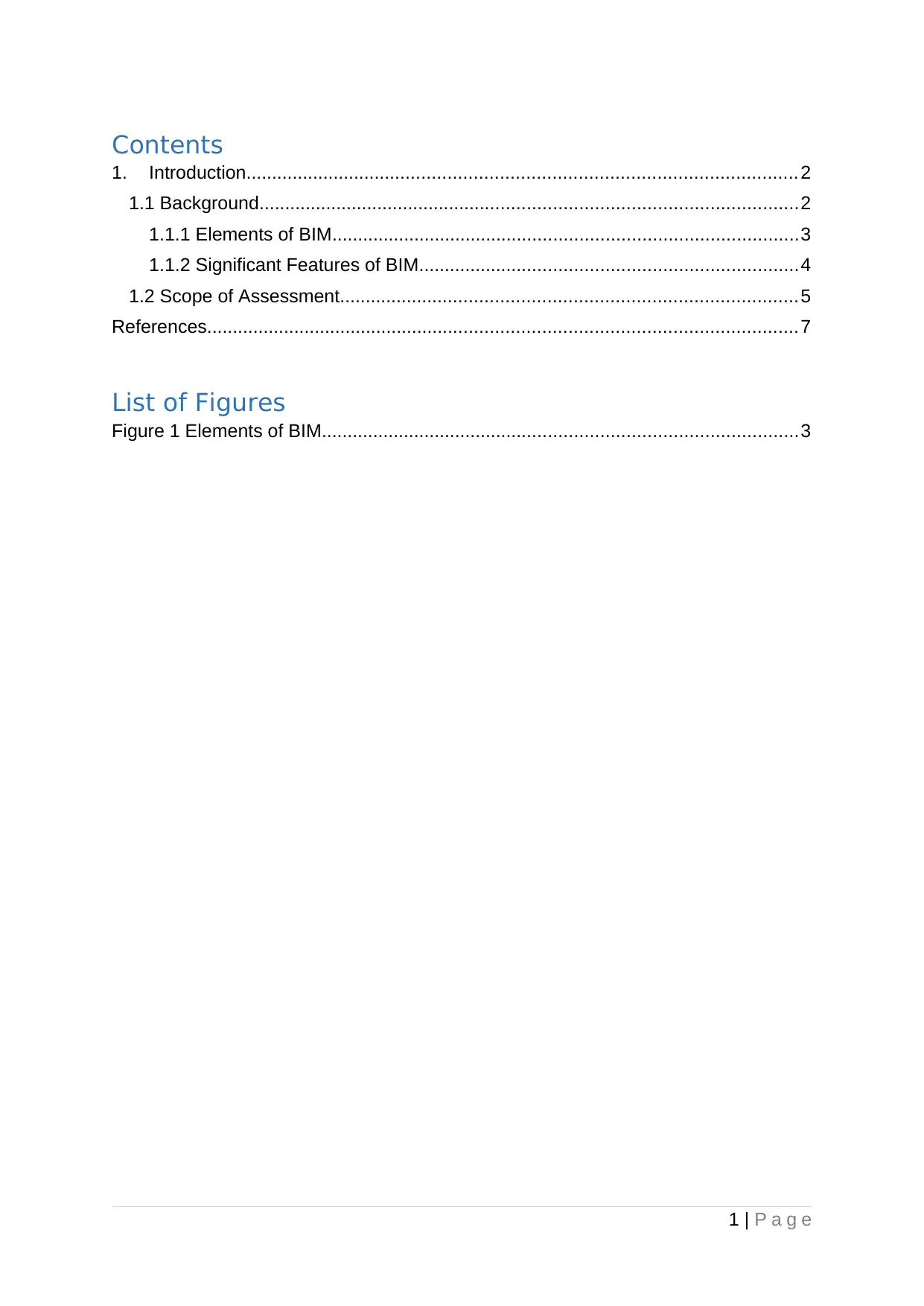
Contents
1. Introduction.......................................................................................................... 2
1.1 Background........................................................................................................2
1.1.1 Elements of BIM..........................................................................................3
1.1.2 Significant Features of BIM.........................................................................4
1.2 Scope of Assessment........................................................................................5
References..................................................................................................................7
List of Figures
Figure 1 Elements of BIM............................................................................................3
1 | P a g e
1. Introduction.......................................................................................................... 2
1.1 Background........................................................................................................2
1.1.1 Elements of BIM..........................................................................................3
1.1.2 Significant Features of BIM.........................................................................4
1.2 Scope of Assessment........................................................................................5
References..................................................................................................................7
List of Figures
Figure 1 Elements of BIM............................................................................................3
1 | P a g e
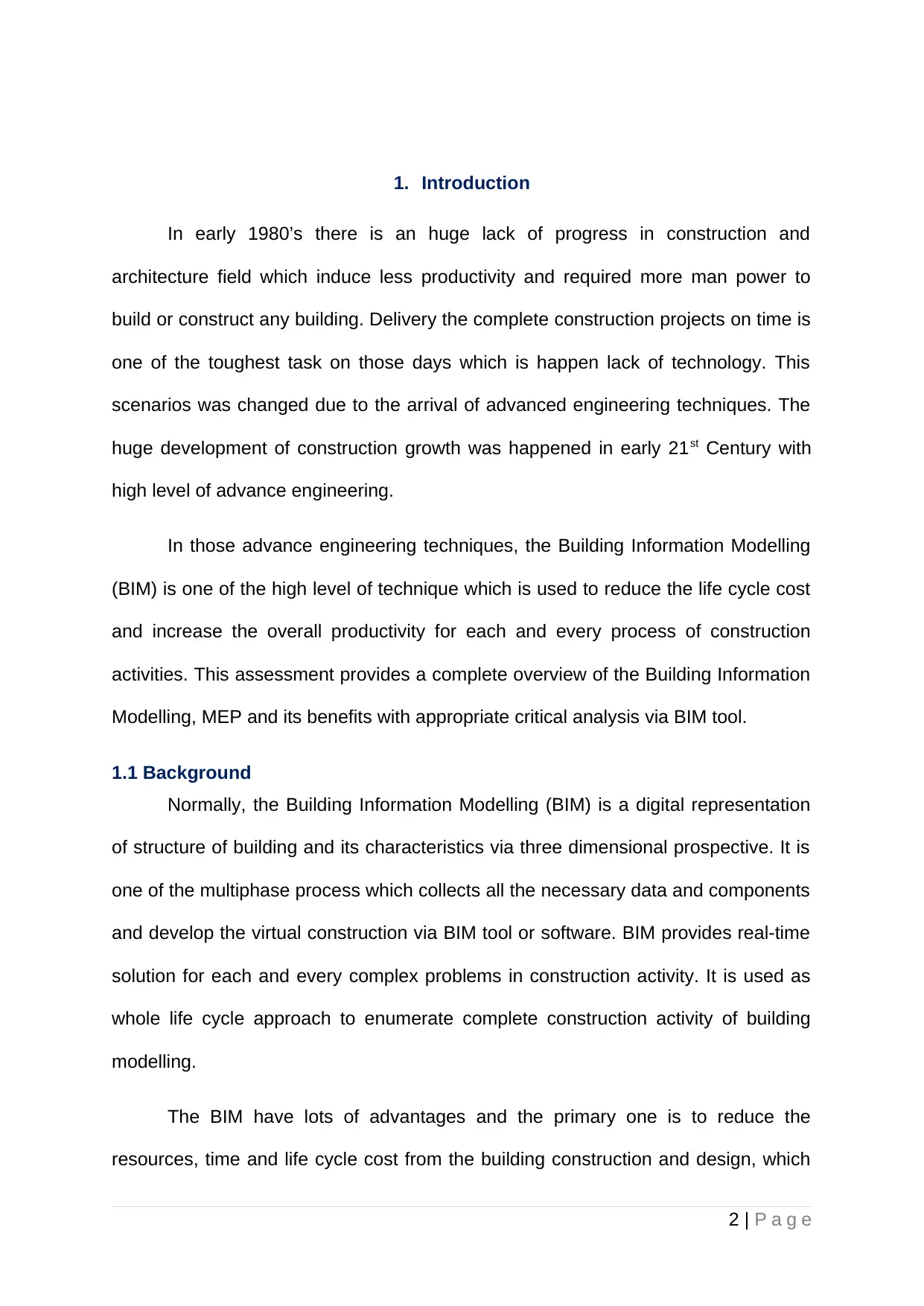
1. Introduction
In early 1980’s there is an huge lack of progress in construction and
architecture field which induce less productivity and required more man power to
build or construct any building. Delivery the complete construction projects on time is
one of the toughest task on those days which is happen lack of technology. This
scenarios was changed due to the arrival of advanced engineering techniques. The
huge development of construction growth was happened in early 21st Century with
high level of advance engineering.
In those advance engineering techniques, the Building Information Modelling
(BIM) is one of the high level of technique which is used to reduce the life cycle cost
and increase the overall productivity for each and every process of construction
activities. This assessment provides a complete overview of the Building Information
Modelling, MEP and its benefits with appropriate critical analysis via BIM tool.
1.1 Background
Normally, the Building Information Modelling (BIM) is a digital representation
of structure of building and its characteristics via three dimensional prospective. It is
one of the multiphase process which collects all the necessary data and components
and develop the virtual construction via BIM tool or software. BIM provides real-time
solution for each and every complex problems in construction activity. It is used as
whole life cycle approach to enumerate complete construction activity of building
modelling.
The BIM have lots of advantages and the primary one is to reduce the
resources, time and life cycle cost from the building construction and design, which
2 | P a g e
In early 1980’s there is an huge lack of progress in construction and
architecture field which induce less productivity and required more man power to
build or construct any building. Delivery the complete construction projects on time is
one of the toughest task on those days which is happen lack of technology. This
scenarios was changed due to the arrival of advanced engineering techniques. The
huge development of construction growth was happened in early 21st Century with
high level of advance engineering.
In those advance engineering techniques, the Building Information Modelling
(BIM) is one of the high level of technique which is used to reduce the life cycle cost
and increase the overall productivity for each and every process of construction
activities. This assessment provides a complete overview of the Building Information
Modelling, MEP and its benefits with appropriate critical analysis via BIM tool.
1.1 Background
Normally, the Building Information Modelling (BIM) is a digital representation
of structure of building and its characteristics via three dimensional prospective. It is
one of the multiphase process which collects all the necessary data and components
and develop the virtual construction via BIM tool or software. BIM provides real-time
solution for each and every complex problems in construction activity. It is used as
whole life cycle approach to enumerate complete construction activity of building
modelling.
The BIM have lots of advantages and the primary one is to reduce the
resources, time and life cycle cost from the building construction and design, which
2 | P a g e
⊘ This is a preview!⊘
Do you want full access?
Subscribe today to unlock all pages.

Trusted by 1+ million students worldwide
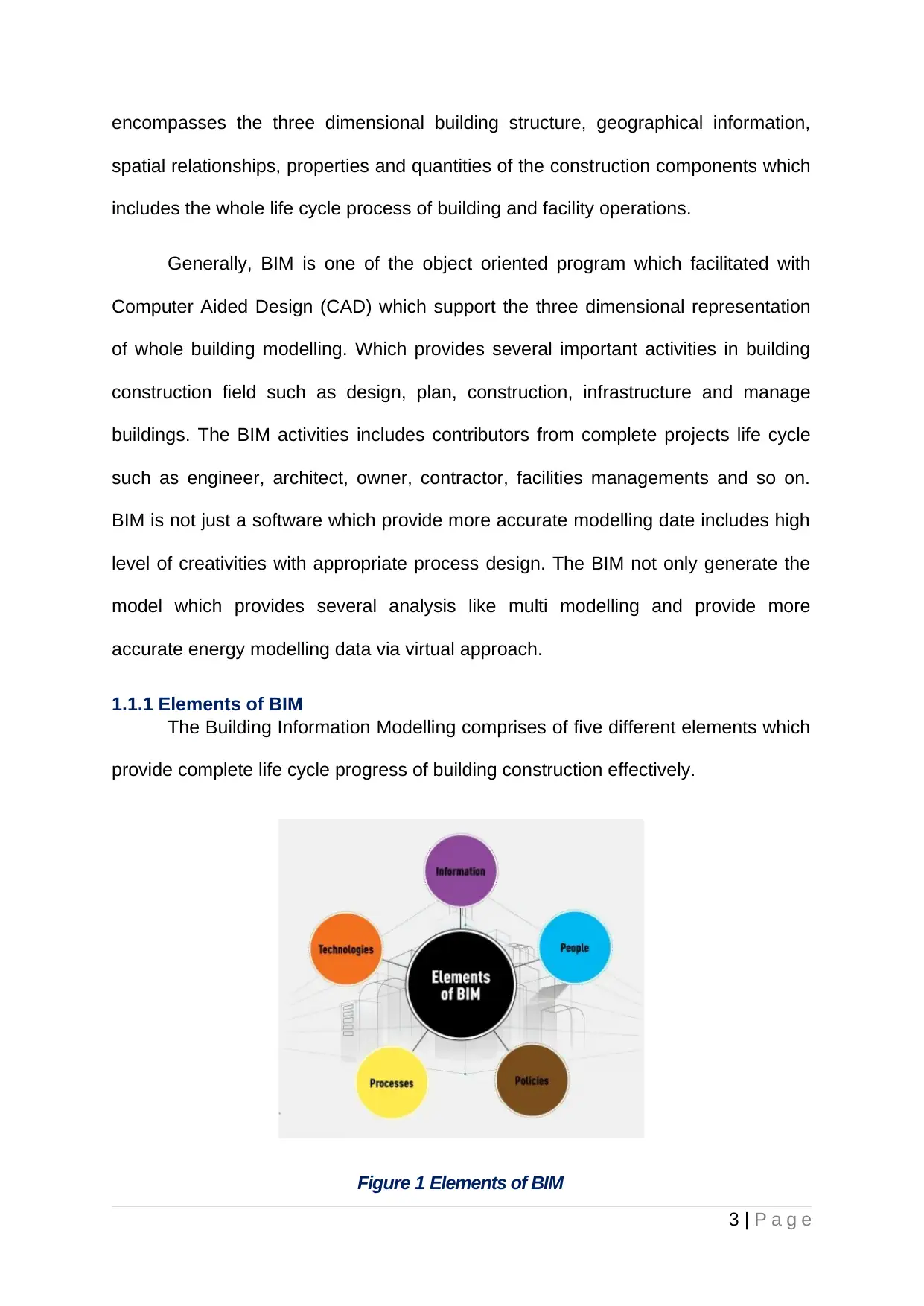
encompasses the three dimensional building structure, geographical information,
spatial relationships, properties and quantities of the construction components which
includes the whole life cycle process of building and facility operations.
Generally, BIM is one of the object oriented program which facilitated with
Computer Aided Design (CAD) which support the three dimensional representation
of whole building modelling. Which provides several important activities in building
construction field such as design, plan, construction, infrastructure and manage
buildings. The BIM activities includes contributors from complete projects life cycle
such as engineer, architect, owner, contractor, facilities managements and so on.
BIM is not just a software which provide more accurate modelling date includes high
level of creativities with appropriate process design. The BIM not only generate the
model which provides several analysis like multi modelling and provide more
accurate energy modelling data via virtual approach.
1.1.1 Elements of BIM
The Building Information Modelling comprises of five different elements which
provide complete life cycle progress of building construction effectively.
Figure 1 Elements of BIM
3 | P a g e
spatial relationships, properties and quantities of the construction components which
includes the whole life cycle process of building and facility operations.
Generally, BIM is one of the object oriented program which facilitated with
Computer Aided Design (CAD) which support the three dimensional representation
of whole building modelling. Which provides several important activities in building
construction field such as design, plan, construction, infrastructure and manage
buildings. The BIM activities includes contributors from complete projects life cycle
such as engineer, architect, owner, contractor, facilities managements and so on.
BIM is not just a software which provide more accurate modelling date includes high
level of creativities with appropriate process design. The BIM not only generate the
model which provides several analysis like multi modelling and provide more
accurate energy modelling data via virtual approach.
1.1.1 Elements of BIM
The Building Information Modelling comprises of five different elements which
provide complete life cycle progress of building construction effectively.
Figure 1 Elements of BIM
3 | P a g e
Paraphrase This Document
Need a fresh take? Get an instant paraphrase of this document with our AI Paraphraser
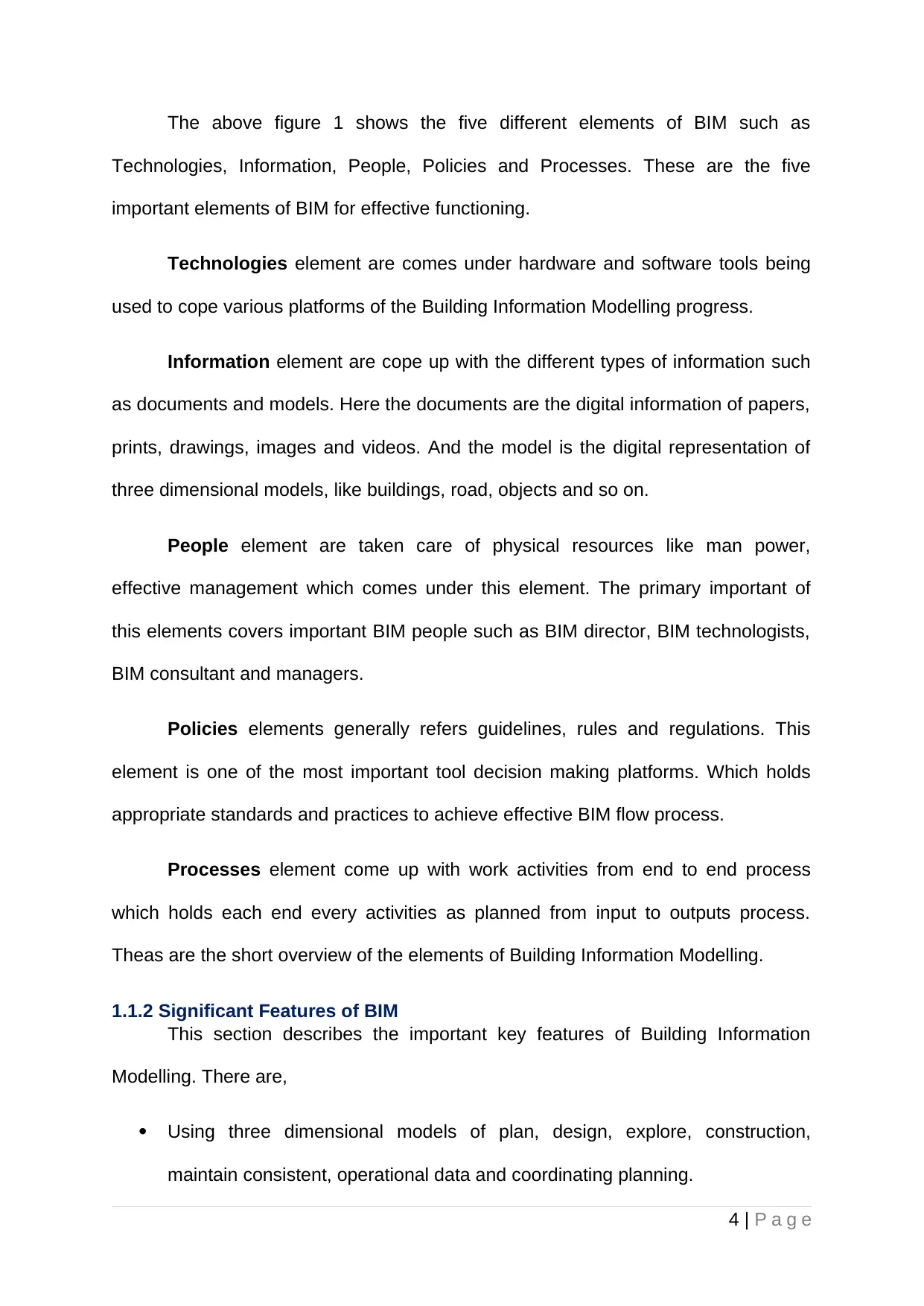
The above figure 1 shows the five different elements of BIM such as
Technologies, Information, People, Policies and Processes. These are the five
important elements of BIM for effective functioning.
Technologies element are comes under hardware and software tools being
used to cope various platforms of the Building Information Modelling progress.
Information element are cope up with the different types of information such
as documents and models. Here the documents are the digital information of papers,
prints, drawings, images and videos. And the model is the digital representation of
three dimensional models, like buildings, road, objects and so on.
People element are taken care of physical resources like man power,
effective management which comes under this element. The primary important of
this elements covers important BIM people such as BIM director, BIM technologists,
BIM consultant and managers.
Policies elements generally refers guidelines, rules and regulations. This
element is one of the most important tool decision making platforms. Which holds
appropriate standards and practices to achieve effective BIM flow process.
Processes element come up with work activities from end to end process
which holds each end every activities as planned from input to outputs process.
Theas are the short overview of the elements of Building Information Modelling.
1.1.2 Significant Features of BIM
This section describes the important key features of Building Information
Modelling. There are,
Using three dimensional models of plan, design, explore, construction,
maintain consistent, operational data and coordinating planning.
4 | P a g e
Technologies, Information, People, Policies and Processes. These are the five
important elements of BIM for effective functioning.
Technologies element are comes under hardware and software tools being
used to cope various platforms of the Building Information Modelling progress.
Information element are cope up with the different types of information such
as documents and models. Here the documents are the digital information of papers,
prints, drawings, images and videos. And the model is the digital representation of
three dimensional models, like buildings, road, objects and so on.
People element are taken care of physical resources like man power,
effective management which comes under this element. The primary important of
this elements covers important BIM people such as BIM director, BIM technologists,
BIM consultant and managers.
Policies elements generally refers guidelines, rules and regulations. This
element is one of the most important tool decision making platforms. Which holds
appropriate standards and practices to achieve effective BIM flow process.
Processes element come up with work activities from end to end process
which holds each end every activities as planned from input to outputs process.
Theas are the short overview of the elements of Building Information Modelling.
1.1.2 Significant Features of BIM
This section describes the important key features of Building Information
Modelling. There are,
Using three dimensional models of plan, design, explore, construction,
maintain consistent, operational data and coordinating planning.
4 | P a g e
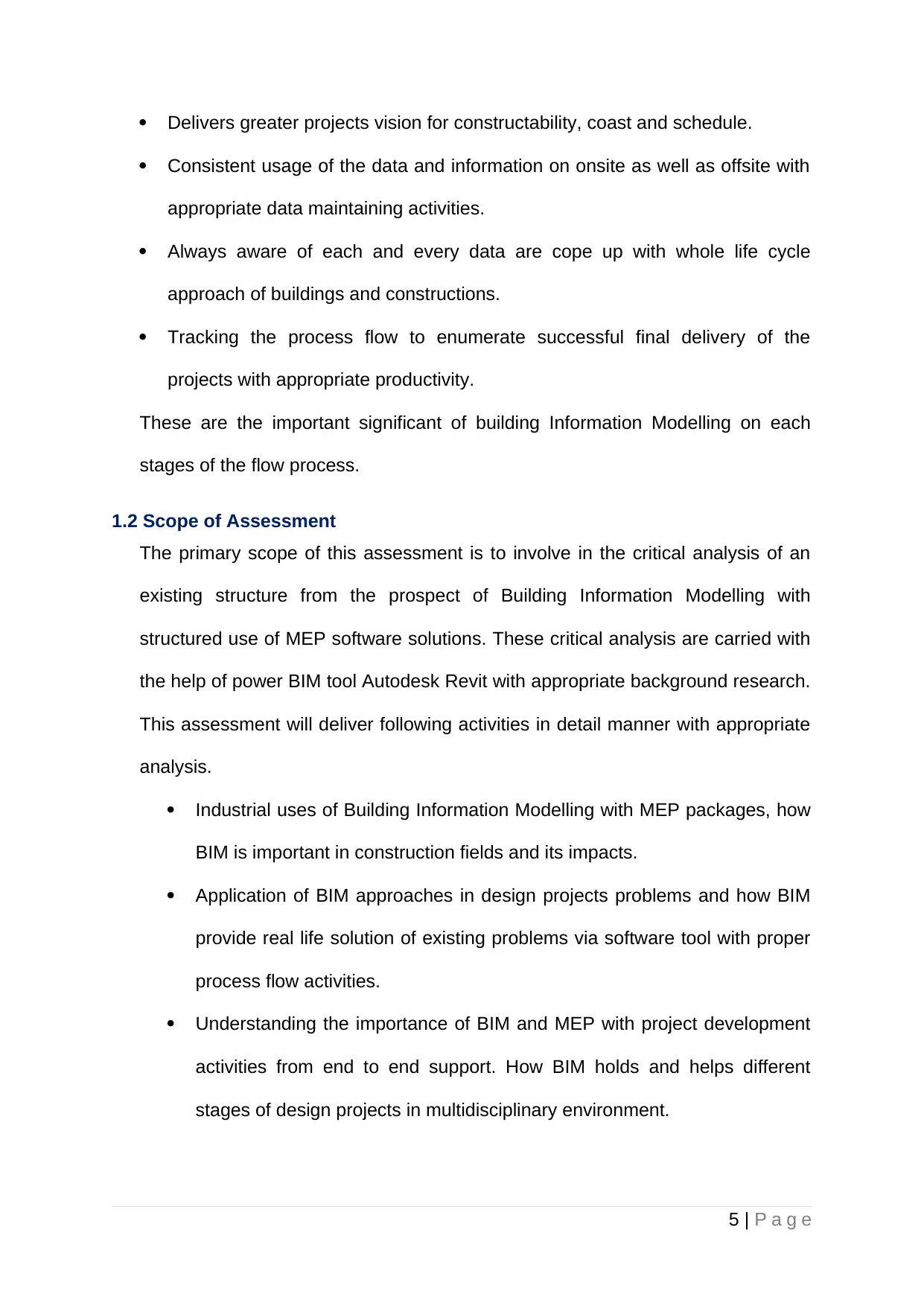
Delivers greater projects vision for constructability, coast and schedule.
Consistent usage of the data and information on onsite as well as offsite with
appropriate data maintaining activities.
Always aware of each and every data are cope up with whole life cycle
approach of buildings and constructions.
Tracking the process flow to enumerate successful final delivery of the
projects with appropriate productivity.
These are the important significant of building Information Modelling on each
stages of the flow process.
1.2 Scope of Assessment
The primary scope of this assessment is to involve in the critical analysis of an
existing structure from the prospect of Building Information Modelling with
structured use of MEP software solutions. These critical analysis are carried with
the help of power BIM tool Autodesk Revit with appropriate background research.
This assessment will deliver following activities in detail manner with appropriate
analysis.
Industrial uses of Building Information Modelling with MEP packages, how
BIM is important in construction fields and its impacts.
Application of BIM approaches in design projects problems and how BIM
provide real life solution of existing problems via software tool with proper
process flow activities.
Understanding the importance of BIM and MEP with project development
activities from end to end support. How BIM holds and helps different
stages of design projects in multidisciplinary environment.
5 | P a g e
Consistent usage of the data and information on onsite as well as offsite with
appropriate data maintaining activities.
Always aware of each and every data are cope up with whole life cycle
approach of buildings and constructions.
Tracking the process flow to enumerate successful final delivery of the
projects with appropriate productivity.
These are the important significant of building Information Modelling on each
stages of the flow process.
1.2 Scope of Assessment
The primary scope of this assessment is to involve in the critical analysis of an
existing structure from the prospect of Building Information Modelling with
structured use of MEP software solutions. These critical analysis are carried with
the help of power BIM tool Autodesk Revit with appropriate background research.
This assessment will deliver following activities in detail manner with appropriate
analysis.
Industrial uses of Building Information Modelling with MEP packages, how
BIM is important in construction fields and its impacts.
Application of BIM approaches in design projects problems and how BIM
provide real life solution of existing problems via software tool with proper
process flow activities.
Understanding the importance of BIM and MEP with project development
activities from end to end support. How BIM holds and helps different
stages of design projects in multidisciplinary environment.
5 | P a g e
⊘ This is a preview!⊘
Do you want full access?
Subscribe today to unlock all pages.

Trusted by 1+ million students worldwide
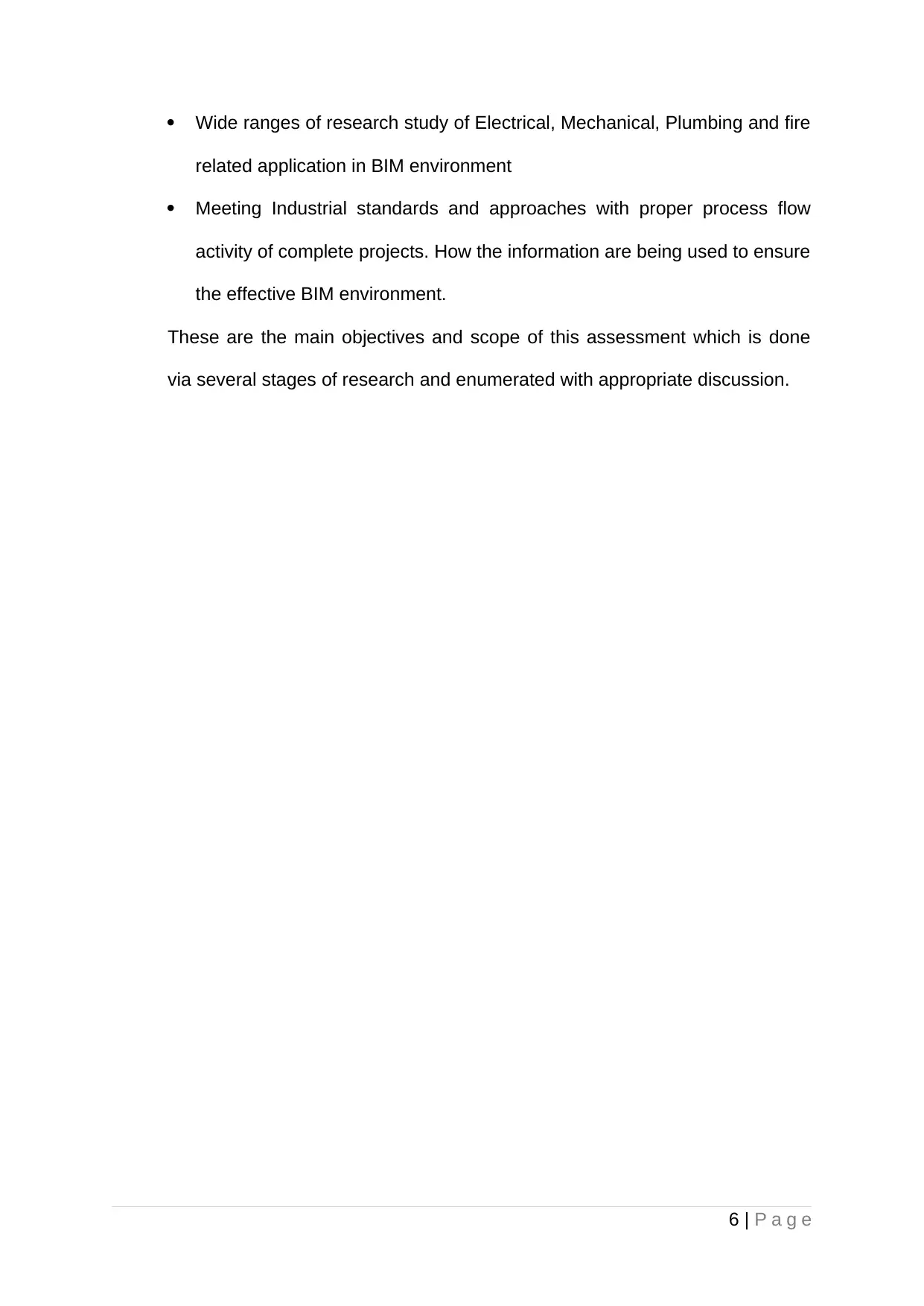
Wide ranges of research study of Electrical, Mechanical, Plumbing and fire
related application in BIM environment
Meeting Industrial standards and approaches with proper process flow
activity of complete projects. How the information are being used to ensure
the effective BIM environment.
These are the main objectives and scope of this assessment which is done
via several stages of research and enumerated with appropriate discussion.
6 | P a g e
related application in BIM environment
Meeting Industrial standards and approaches with proper process flow
activity of complete projects. How the information are being used to ensure
the effective BIM environment.
These are the main objectives and scope of this assessment which is done
via several stages of research and enumerated with appropriate discussion.
6 | P a g e
Paraphrase This Document
Need a fresh take? Get an instant paraphrase of this document with our AI Paraphraser
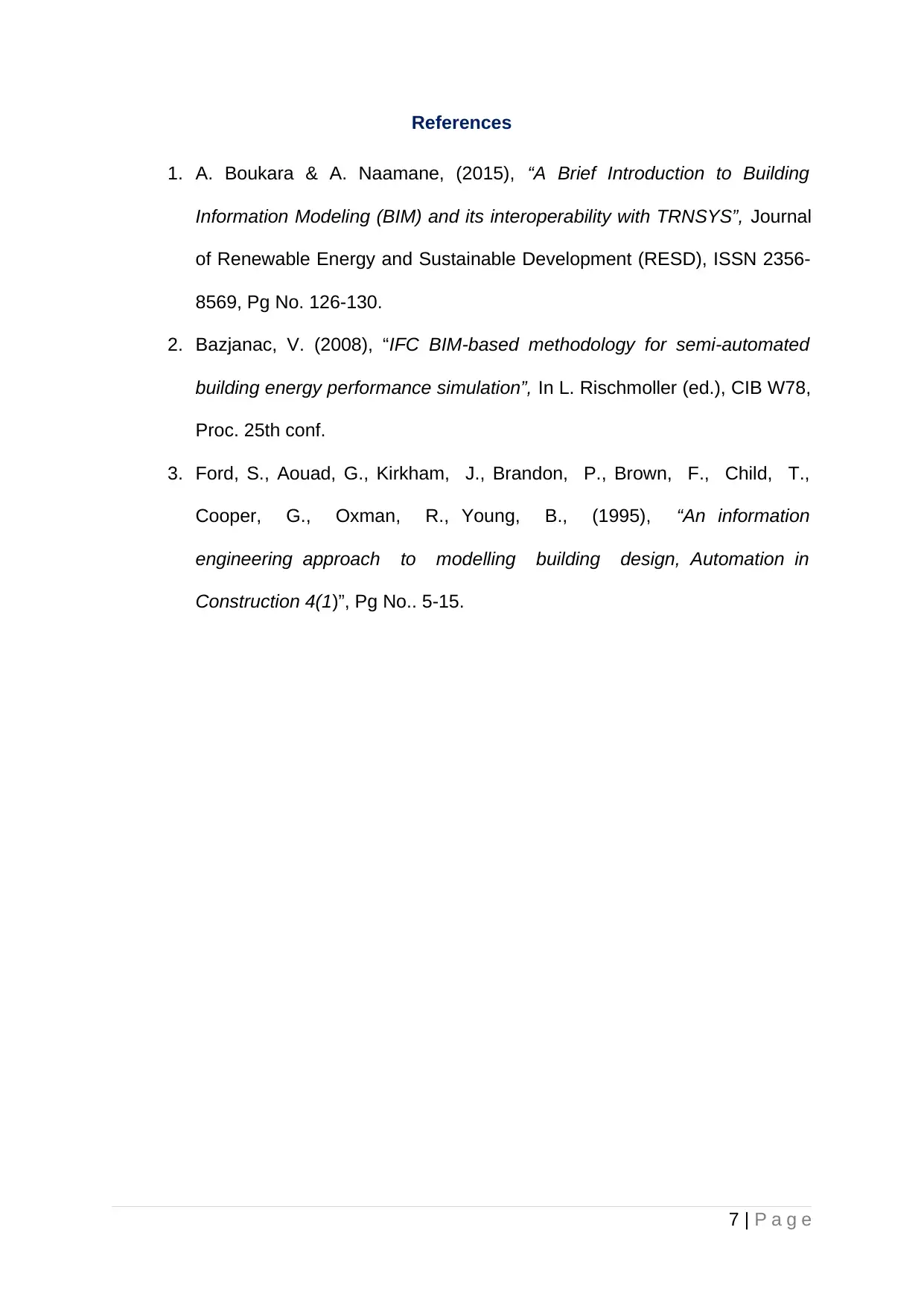
References
1. A. Boukara & A. Naamane, (2015), “A Brief Introduction to Building
Information Modeling (BIM) and its interoperability with TRNSYS”, Journal
of Renewable Energy and Sustainable Development (RESD), ISSN 2356-
8569, Pg No. 126-130.
2. Bazjanac, V. (2008), “IFC BIM-based methodology for semi-automated
building energy performance simulation”, In L. Rischmoller (ed.), CIB W78,
Proc. 25th conf.
3. Ford, S., Aouad, G., Kirkham, J., Brandon, P., Brown, F., Child, T.,
Cooper, G., Oxman, R., Young, B., (1995), “An information
engineering approach to modelling building design, Automation in
Construction 4(1)”, Pg No.. 5-15.
7 | P a g e
1. A. Boukara & A. Naamane, (2015), “A Brief Introduction to Building
Information Modeling (BIM) and its interoperability with TRNSYS”, Journal
of Renewable Energy and Sustainable Development (RESD), ISSN 2356-
8569, Pg No. 126-130.
2. Bazjanac, V. (2008), “IFC BIM-based methodology for semi-automated
building energy performance simulation”, In L. Rischmoller (ed.), CIB W78,
Proc. 25th conf.
3. Ford, S., Aouad, G., Kirkham, J., Brandon, P., Brown, F., Child, T.,
Cooper, G., Oxman, R., Young, B., (1995), “An information
engineering approach to modelling building design, Automation in
Construction 4(1)”, Pg No.. 5-15.
7 | P a g e
1 out of 8
Related Documents
Your All-in-One AI-Powered Toolkit for Academic Success.
+13062052269
info@desklib.com
Available 24*7 on WhatsApp / Email
![[object Object]](/_next/static/media/star-bottom.7253800d.svg)
Unlock your academic potential
Copyright © 2020–2025 A2Z Services. All Rights Reserved. Developed and managed by ZUCOL.





